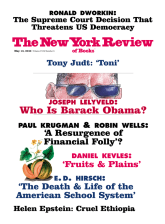In response to:
The Cabinet of Dr. Strangelove from the February 25, 2010 issue
To the Editors:
Steve Coll’s review of Neil Sheehan’s A Fiery Peace in a Cold War [NYR, February 25] is important given current debates over nuclear deterrence and the accuracy of US intelligence, viz. Iran and the 2003 Iraq invasion. But a much more significant correction to the essay is needed than the one you ran in NYR’s March 11 issue about who in fact had attended a 1955 White House planning meeting.
“From the U-2 photography,” Mr. Coll writes, “Eisenhower knew that candidate John F. Kennedy’s claims in 1960 about a ‘missile gap’ between the US and the Soviet Union were untrue, but Eisenhower had to swallow his frustration in silence, lest he reveal the U-2’s existence.” This is an enduring cold war myth, as I explained in my book The Fifty-Year Wound: How America’s Cold War Victory Shapes Our World (Little, Brown, 2002).
U-2 reconnaissance of the Soviet Union had begun in summer 1956. Moscow tracked the flights immediately despite CIA promises to Eisenhower that the jet’s altitude would make it undetectable. The flights effectively came to a standstill: only two penetrations were flown in 1959. Above all, Eisenhower wanted negotiations with Soviet Premier Nikita Khrushchev and feared that U-2 incursions would compel the Kremlin to cancel them. In September, Khrushchev came to the United States and boasted of his new ICBM armory. The Democrats turned up the heat on Ike about a “gap.”
Eisenhower allowed an additional U-2 flight in February 1960, covering the test ranges of Kapustin Yar and Tyuratam east of the Urals near Stalingrad. Results were ambiguous. More U-2 photos were urged by CIA Director Allen Dulles. So an additional mission was flown in April over Tyuratam, the nuclear test facilities at Semipalatinsk, and the early antiballistic missile test range at Sary Shagan. Still there were no signs of ICBMs, though the CIA and Air Force were convinced that the Soviets had them in abundance.
In fact, the U-2s were concentrating on Soviet R&D facilities, not searching out ICBM sites in the most likely places. Such evidence could have been found only west of the Urals, in European Russia. Eisenhower was rightly nervous about penetrating this heavily defended area. That would be permitted only on the ill-fated May 1960 mission. Had the CIA’s most experienced pilot, thirty-year-old Francis Gary Powers, completed his flight, the missile gap would indeed have been disproved while Eisenhower was in office.
Powers took off from Pakistan on May 1 at 6:26 AM, attempting for the first time to cross the Soviet Union from the south to the northwest. Navigating over the peaks of the Hindu Kush, then over Central Asia, his destination Norway, he was en route to take photographs of the SS-6 complex north of Leningrad. The CIA had thus far been unable to scrutinize more than just the test ranges (it would be several years before ICBMs would be deployed in Kazakhstan). But the Russians finally showed that they could knock out the U-2 at the edge of space.
There would be no further flights over the Soviet bloc. The true nature of the missile gap thus remained a mystery. Not until 1961, months after Eisenhower left office, did photos from the new Corona spy satellite prove that the gap favored the United States.
Here is why the correct story is pivotal: the CIA can’t—or won’t—get this chronology correct. “President Eisenhower,” CIA director George Tenet insisted in the late 1990s, “knew for certain—for certain—that we had no bomber gap and no missile gap with the Soviet Union.” (A bomber gap was no longer the question; even the USAF acknowledged there was none.) Langley’s is a culture that rarely admits error, even one as old and as documentable as this, and it’s a bureaucracy in which not even twenty-five-year veterans can recall a single case of someone being fired for failing to perform. This has gone on decade after decade after decade.
Derek Leebaert
Washington, D.C.



